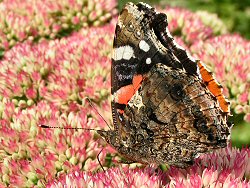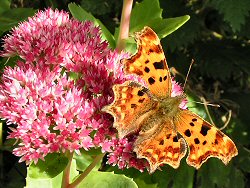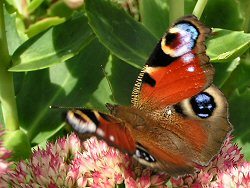Here we are well into September, but over the last week or two I think that I've seen more butterflies in my garden than I have over the whole summer; and it's all thanks to one plant.
 A red admiral (Vanessa atalanta) on Sedum spectabile.
A red admiral (Vanessa atalanta) on Sedum spectabile.
Any garden at this time of year is enlivened by a good dash of
Sedum spectabile. In south Essex, where I grew up, we used to call these 'ice plants' though up here in Lancashire they use that name for another plant. The name 'ice plant' doesn't do them justice though because their pink inflorescences shine like jewels in the garden at this time of year. These flat-topped and nectar-rich flowers themselves attract further jewels in the shape of butterflies. At the weekend I counted no less than seven red admirals together on my
Sedums: that may not be an impressive total for some of you spoilt southerners, but I can assure you it's a good total for these latitudes!
 A comma (Polygonia c-album) on Sedum spectabile.
A comma (Polygonia c-album) on Sedum spectabile.
Many of our most spectacular (and thankfully most common) butterflies belong to a group known as the aristocrats, which together with the fritillaries make up the family called the nymphalids. The nymphalids are characterised by having short non-functional front legs which gives them the appearance of only having two pairs of legs. Have a good look at any comma (
Polygonia c-album), small tortoiseshell (
Aglais urticae), peacock (
Inachis io), red admiral (
Vanessa atalanta) or painted lady (
Cynthia cardui) and you will notice only two obvious pairs of legs.
 A peacock (Inachis io) on Sedum spectabile.
A peacock (Inachis io) on Sedum spectabile.
Another characteristic of the aristocrats is that most of them hibernate as adults through the winter: small tortoiseshells and peacocks are very often aroused early from hibernation when disturbed in sheds or garages or when the central heating comes on in the main house. If you ever come across an disturbed butterfly like this, it is best to release it somewhere sheltered but cold - such as a garage or shed - where it will soon settle down for the rest of the winter. Red admirals and painted ladies do not often survive the winter in Britain as adults - instead they adopt another strategy by migrating to southern climes. Whether migrating or hibernating, these butterflies must build up reserves of energy at this time of year which is why
Sedum spectabile is such a magnet for them just now.